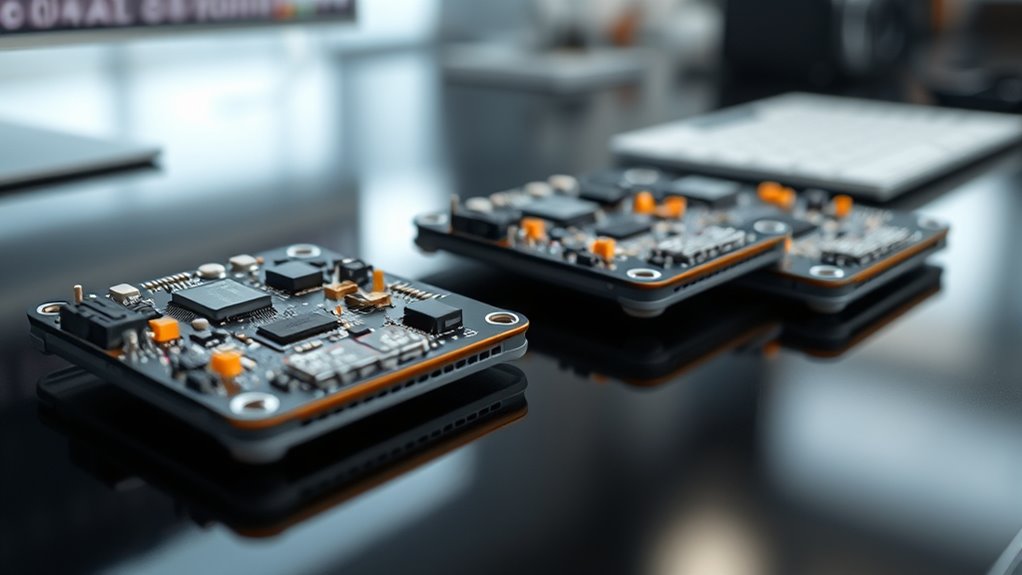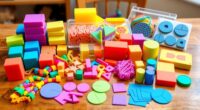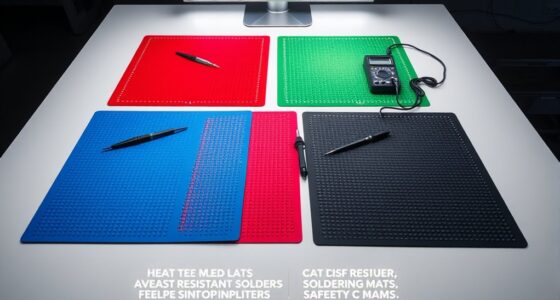If you’re looking for the best secure element dev board in 2025, I recommend one that offers broad compatibility with microcontrollers, including I2C, SPI, and UART interfaces. It should support strong security protocols like RSA, ECC, and AES, while offering flexible power options and various connectivity choices such as Bluetooth or Wi-Fi. An ideal board also simplifies development with excellent IDE support and detailed documentation. Keep exploring to discover which board perfectly fits your project needs and guarantees top-tier security.
Key Takeaways
- Compatibility with popular development environments like Arduino, PlatformIO, and Eclipse ensures easy integration.
- Support for industry-standard security protocols such as RSA, ECC, and AES guarantees robust security features.
- Flexible power options, including USB, batteries, and external power supplies, enable portable and remote deployments.
- Multiple wired (I2C, SPI, UART, USB) and wireless (NFC, Bluetooth, Wi-Fi) connectivity options facilitate versatile system integration.
- Hardware-based security features like secure boot, tamper resistance, and secure firmware updates enhance device integrity.
SparkFun Qwiic Pro Micro USB-C Microcontroller Board
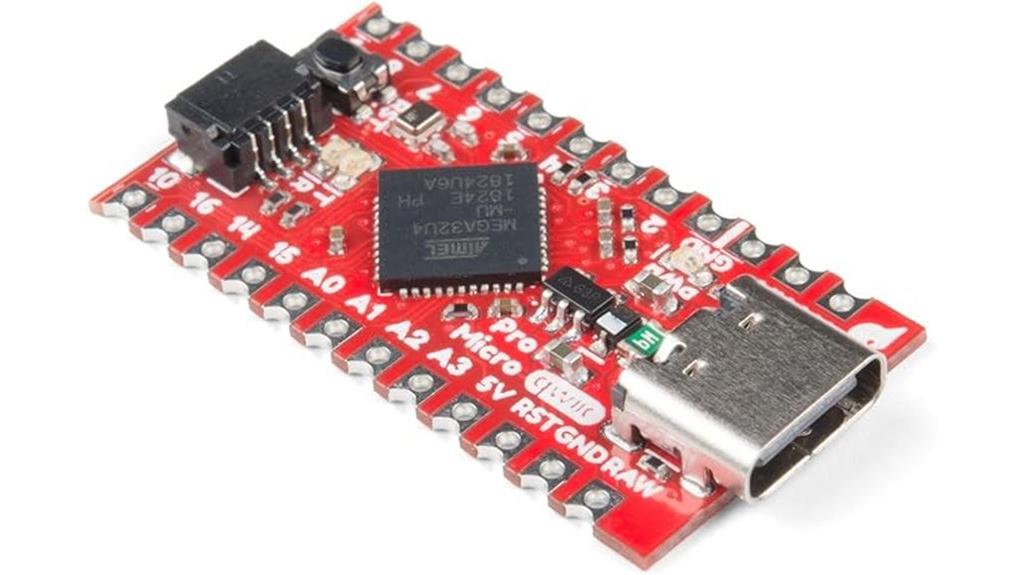
Are you looking for a versatile development board that combines ease of use with robust connectivity? The SparkFun Qwiic Pro Micro USB-C Microcontroller Board is an excellent choice. It features an Arduino-compatible design with a Reset button, 12 digital I/O pins (5 PWM), and 9 ADC pins. Powered by the ATmega32U4 running at 5V/16MHz, it supports the Arduino IDE. The onboard USB-C port simplifies programming and power. With a Qwiic connector for easy I2C and SPI integration, plus castellated PTH pads for mounting, this compact board offers reliable power regulation and multiple communication options, making it perfect for diverse projects.
Best For: hobbyists, students, and developers seeking an easy-to-use, Arduino-compatible microcontroller with versatile connectivity and compact design.
Pros:
- Easy programming via USB-C port with support for Arduino IDE
- Multiple communication interfaces including I2C, SPI, and serial
- Compact size with castellated PTH pads for flexible mounting
Cons:
- Limited to 6V input voltage, requiring careful power management
- Only 12 digital I/O pins, which may be restrictive for complex projects
- ATmega32U4 microcontroller may not be suitable for high-performance applications
Factors to Consider When Choosing Secure Element Dev Boards
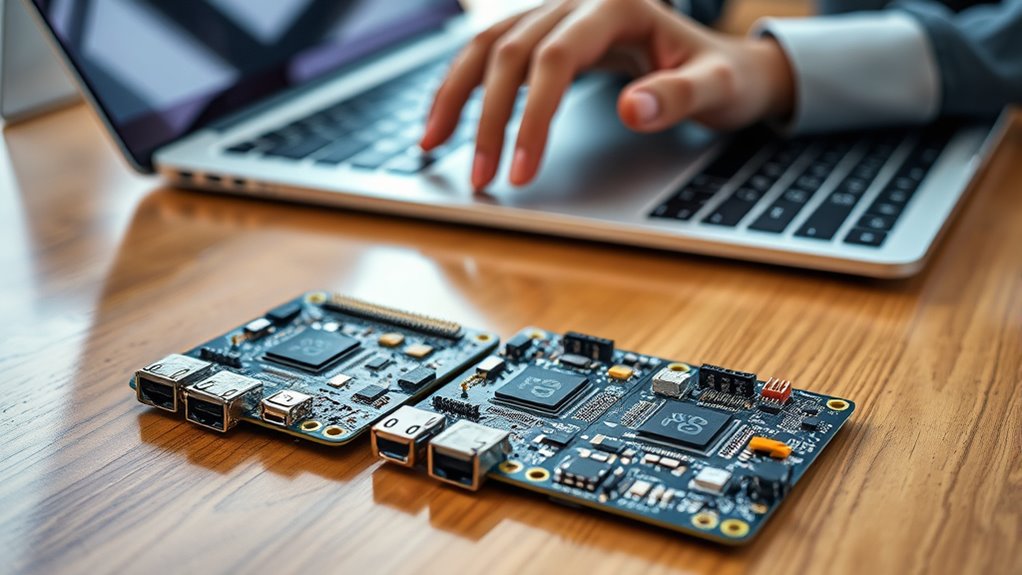
When selecting a secure element dev board, I focus on how well it fits my project requirements and supports essential security protocols. I also consider power options, connectivity features, and how user-friendly the development environment is. These factors help guarantee I choose a board that’s both reliable and easy to work with.
Compatibility With Projects
Choosing a secure element development board that integrates seamlessly with your project requires careful consideration of compatibility factors. First, verify the board supports the communication interfaces your project needs, like I2C, SPI, or UART. Next, confirm that the microcontroller on the board aligns with your existing hardware and development environment to avoid integration issues. Power requirements are also critical; check that the board’s voltage and power needs match your power supply setup. Physical compatibility matters too—consider form factor, connector types, and mounting options to ensure it fits within your design constraints. Finally, review the board’s security features and supported protocols to confirm they meet your application’s security requirements. Prioritizing these factors helps ensure smooth integration and successful deployment.
Security Protocol Support
Supporting a wide range of cryptographic protocols like RSA, ECC, and AES is vital for secure element development boards, as it guarantees flexibility in implementing various security measures. This ensures compatibility with diverse security applications and standards. Equally important is support for industry standards such as PKCS#11, GlobalPlatform, and ISO/IEC 7816, which streamline integration and enhance interoperability. A secure board must also include hardware-based features like secure boot and firmware updates to prevent unauthorized code execution. Robust key management protocols, including tamper resistance and secure storage, are essential for safeguarding sensitive credentials. Additionally, thorough security features like mutual authentication, encrypted communication channels, and hardware random number generators help establish a multi-layered defense, ensuring the integrity and confidentiality of sensitive data.
Power Supply Flexibility
A secure element development board with flexible power options guarantees reliable operation across a variety of environments and applications. I look for boards that support multiple power sources like USB, batteries, or external adapters, which makes them versatile for portable and remote setups. Compatibility with different voltage levels ensures the secure element stays protected from overvoltage or undervoltage issues, maintaining security integrity. A well-designed power supply minimizes noise and fluctuations that could interfere with the secure element’s functions. Supporting multiple power input methods simplifies integration into complex systems where power availability varies. This flexibility not only enhances reliability but also broadens application possibilities, giving me confidence that the board can operate seamlessly in diverse scenarios without additional power management components.
Connectivity Options Available
When evaluating secure element development boards, I pay close attention to the available connectivity options, as they directly affect communication reliability and security. Many boards support standard wired interfaces like I2C, SPI, UART, and USB, which are vital for stable data exchange with other devices. Wireless options such as NFC, Bluetooth, and Wi-Fi can considerably enhance secure data transfer without extra hardware, making integration more flexible. It’s essential that wired connections are compatible with the microcontroller’s protocols to guarantee dependable security. Some boards also feature dedicated connectors like Qwiic or Grove, simplifying module integration. Overall, the connectivity choices impact not just security and data throughput but also how easily the board can be integrated into various application environments.
Development Environment Ease
Choosing the right development environment can greatly streamline your work with secure element boards. Support for popular IDEs like Arduino, PlatformIO, or Eclipse makes coding and debugging more straightforward, saving time and reducing frustration. Compatibility with common programming languages such as C/C++ or Python further eases integration, helping you get started quickly without a steep learning curve. Clear, all-encompassing documentation—including sample code and tutorials—can make or break your development experience, so look for boards that offer detailed guides. Pre-installed libraries and SDKs for security protocols simplify implementing secure features right out of the box. Additionally, seamless flashing and firmware updates via USB or OTA methods boost efficiency, allowing you to focus more on development and less on setup hassles.
Frequently Asked Questions
How Do Secure Element Dev Boards Integrate With Existing Iot Systems?
Secure element dev boards integrate with existing IoT systems by connecting via standard interfaces like I2C, SPI, or UART. I program them to communicate securely with microcontrollers and sensors, ensuring data encryption and authentication. I also use APIs and SDKs provided by the boards to streamline integration, allowing seamless communication between the secure element and other IoT components. This helps me enhance security without overhauling my entire system.
What Is the Typical Learning Curve for New Developers?
I’d say the learning curve for new developers is like climbing a gentle hill—initially steep but quickly leveling out. At first, you might feel overwhelmed by unfamiliar security protocols and hardware integration, but with hands-on practice and clear tutorials, it becomes more intuitive. Within a few weeks, I found myself confidently steering through the tools, turning complex concepts into manageable steps. Stick with it, and you’ll gain expertise faster than you expect.
Are There Open-Source Options Available for Secure Element Development?
Yes, there are open-source options available for secure element development. I’ve explored platforms like OpenSmartCard and Google’s Project Treble, which provide accessible tools and documentation. These options allow me to experiment, customize, and understand secure element architecture without relying solely on proprietary hardware. Open-source projects foster a collaborative environment, making it easier to learn, troubleshoot, and innovate in secure element development.
How Do Security Features Vary Between Different Dev Board Models?
Think of security features like layers of armor—each model offers a different level of protection. Some boards focus on hardware encryption, tamper resistance, and secure boot, while others emphasize secure storage and communication protocols. I’ve seen variations where certain boards include biometric authentication or real-time threat monitoring. Ultimately, it’s vital to match a dev board’s security features to your project’s specific needs, ensuring robust protection from the ground up.
What Is the Typical Cost Range for High-Security Dev Boards?
High-security dev boards generally cost between $200 and $1,000, depending on features and security levels. I’ve found that more advanced models with robust encryption and tamper-resistant hardware tend to be on the higher end. If you’re just starting, you might find good options around $200-$500, but for enterprise-grade security, expect to invest closer to $1,000. It’s worth considering your project’s security needs to choose the right board.
Conclusion
In my experience, choosing the right secure element dev board really hinges on compatibility and security features that match your project needs. I believe that with the right tools, like the SparkFun Qwiic Pro Micro, you can confidently develop secure, reliable applications. Trusting that these boards are designed with strong security protocols in mind helps me sleep better at night. So, I encourage you to select a board that aligns with your goals—your future projects will thank you.
